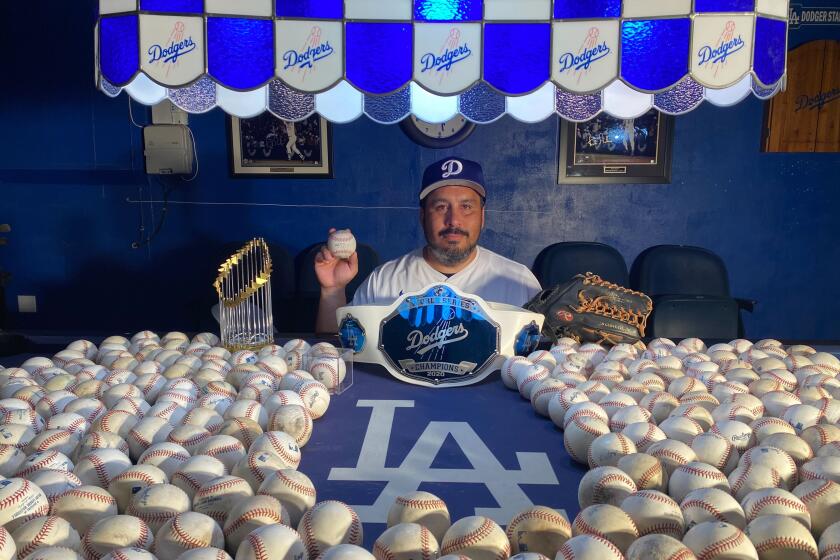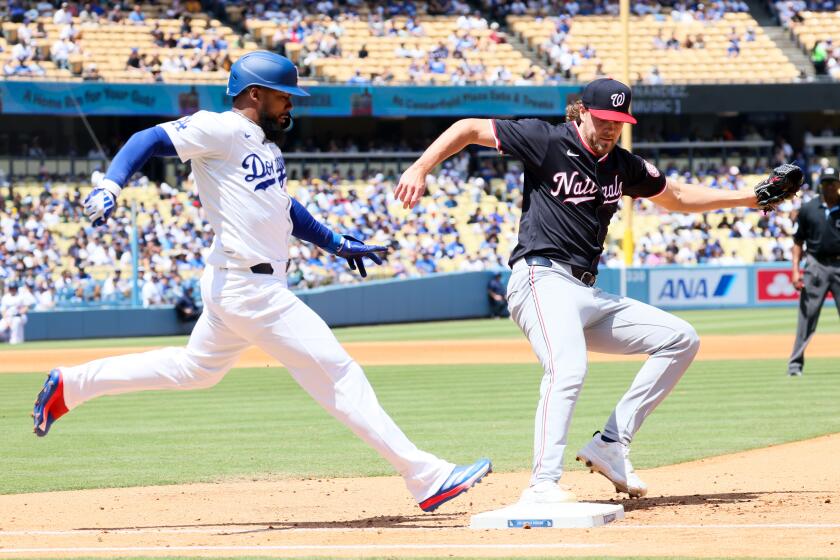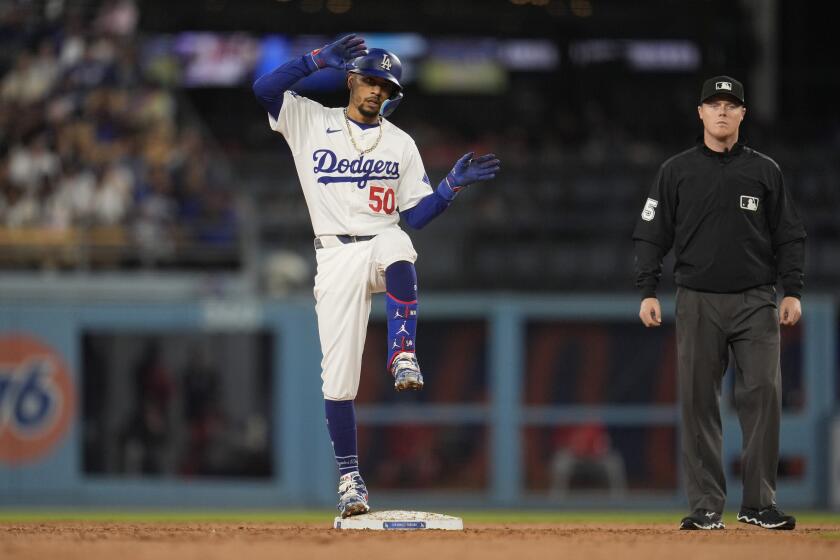Dodgers headed way off-base
The 61st spring encampment at the former Navy base that became Dodgertown in 1948 will be the last for the Dodgers in Vero Beach, Fla., another in the chain of broken links to Brooklyn.
The Dodgers -- whose pitchers and catchers report to camp Thursday -- are slated to move to Glendale, Ariz., for spring training in 2009. Packing will be a sentimental journey for many. Nostalgia is certain to overflow.
“You think of all the great players who trained there, the era when 600 and 700 players lived in the old barracks, the intimacy with the fans, to me it’s been the greatest sports complex of any in the country,” eulogized Tom Lasorda, who arrived in Vero Beach as a player in that initial year and returned in virtually every baseball capacity over the ensuing six decades.
“To me, what we experienced and accomplished in Vero will never be duplicated.”
A spring prototype, Dodgertown has housed a baseball panorama, from the ownership of Branch Rickey to Walter O’Malley to Frank McCourt, from Leo Durocher to new Manager Joe Torre, from the pioneering Jackie Robinson to James Loney.
The memory bank is full.
Yet there are some who still can’t forgive the racism they encountered as African American players in the early years of Dodgertown (“I have no good memories,” said Don Newcombe) and others who came along years later and said the six or seven weeks there had the feel of house arrest.
“You were definitely ready to break out,” Eric Karros said.
Perhaps it will always be more Zero Beach than Vero Beach for some, but it has been a second home to the Dodgers, unique among all training facilities. Even if the Baltimore Orioles leave Fort Lauderdale to take up residence there next year, would Orioletown or Birdland have the same magical ring?
Would a new team be able to create its own memories amid the ghosts? What would happen to the walkways and driveways named in honor of Sandy Koufax, Vin Scully, Roy Campanella and other Dodgers bluebloods?
Dodgertown, after all, is where Campy had his corner and tutored catchers from his wheelchair and where Maury Wills still has Maury’s Pit from which he gives bunting and basestealing lessons.
It is where O’Malley played poker with reporters in the press room at night, where the food was green and Wills or Tommy Hutton might play the banjo at the annual St. Patrick’s Day party, and where Scully, as a young broadcaster, had a barracks room near the Western Union office from which reporters sent their stories and he could never be sure which wayward writer would stumble through at a late hour or end up in the cot next to his, unable to negotiate the darkness.
It is where Rickey, the legendary Mahatma, first set up a strike zone of strings through which pitchers aimed to sharpen their control in workouts after the camp was awakened by a 6 a.m. whistle, where he or his staff gave nightly lectures, and where to be summoned by Rickey for individual tutoring was akin to being “summoned by the Pope,” Lasorda said. (Rickey “saw the creation of a complex not so much as a training base but as an instructional school,” recalled Buzzie Bavasi, who was a 31-year-old minor league general manager when sent by the Dodgers to seal the deal with city officials in Vero.)
It is where, in the late 1940s and early ‘50s, 600 or more players wore numbers differentiated by colors because the Dodgers had 25 or more farm clubs; where the players often slept six or more to a barracks room; where Bobby Bragan took one look at the primitive conditions and said, “Where are the barbed wires and dogs?” Or as Jim Murray, the renowned columnist of The Times, would later write during a trip there, “I lived in Cellblock 7.”
It is where players often carried bats from clubhouse to diamond as protection against snakes; where armadillos roamed the grounds and spiders infiltrated rooms devoid of air and heat (throw rugs were often used as extra blankets and players occasionally slept in uniforms); where running water might come from the ceiling in addition to the tap and the thin walls were no sound barrier -- as an example of which, the post-curfew return of Koufax and Larry Sherry one night so angered Walter Alston, their awakened manager, that he pounded on their door with such ferocity that he lost a diamond from his 1959 World Series ring.
It is also where the long encampments were often enlivened by running pranks, some more devilish than others. Who can forget how the never-to-be-fooled-with Kirk Gibson walked out shortly after he first joined the club in Vero because Jesse Orosco had lined the inside of his cap with eye black, leaving a ring around Gibson’s forehead?
No one, however, was more a foil than Lasorda, victimized consistently by the “Green Phantom” (evidence pointed to Jim Lefebvre with assistance from Wes Parker) through the early ‘70s. The innovative Phantom once stripped Lasorda’s barracks room of everything and filled it almost to the ceiling with newspapers, and another time removed the tires from O’Malley’s golf cart and planted them under Lasorda’s cot, where they were discovered by the tipped-off O’Malley, who staged a midnight raid on the sleeping and unsuspecting Lasorda. And where the Phantom left off, Jay Johnstone and Jerry Reuss later picked up, on one occasion locking Lasorda in his room by using a rope to tie the door handle to a nearby tree after rendering his room phone useless.
Memories, Lasorda said, fill the scrapbook of his mind, and he is not alone.
“Dodgertown was unique,” said Peter O’Malley, whose family owned the team for 48 years and who is now saddened by the move to Arizona.
“Owners would come from different organizations to see what all the attention was about,” he said, “but with all the facilities that have followed, I don’t believe there has been another where you had the same atmosphere and experience, with the owner, president and all the club officials staying on the base and living on the base with the players, and all of that served to bring us together.
“It was a special period of time and that period is gone, whether the barracks are there or not, whether the Dodgers are there or not.”
Despite a mock “Save the Barracks” campaign by Ron Fairly and Don Sutton, the barracks came down in 1972-73 and were replaced by what the Dodgers generously called villas.
It was the first of several major rebuilding projects, but McCourt and wife Jamie are now being afforded real estate opportunities in Arizona that surpass any tug of Dodgertown nostalgia.
At a time when spring training has become big business, the Dodgers are restricted in seating and concession and merchandise opportunities at sun-baked Holman Stadium (there is no roof) and can no longer count on generations of Brooklyn fans making Vero a vacation destination.
In addition, with an increasing number of teams now training in the booming Phoenix/Tucson nexus, every away game in Florida has become a taxing trip amid heavy traffic.
“I remember one time,” Karros said, “that we had such bad rain for several days that there were no dry fields within 200 miles of us, but Orel [Hershiser] had to get his innings in and we bused close to four hours so he could pitch a simulated game. A simulated game. You had to be kidding me.”
Karros, now a Fox analyst, went to Dodgertown for the first time in 1989. His views are probably similar to those of most Dodgers of the last 20 years.
“At that time,” he said, “it was still a jewel. You had everybody living on the grounds and interacting with each other. Here I was a minor league guy and I’m eating in the same place where Tommy is eating, and Campy is there, the big league guys are there, and Koufax is walking around.
“I wouldn’t trade that experience for anything and you’re not going to replicate it. It’s something that was forever valuable for me, but things change.
“The economics and the environment are entirely different now, and in Arizona the club’s California fan base will be a lot closer, there will be more entertainment options, the travel will be less tenuous for the players and there should be more seating in a new stadium.
“There’s no denying that for many years Dodgertown was a great experience for both fans and players, but the move makes absolute sense.”
Dollars and sense?
Even the Dodgertown ghosts probably will understand.
And to some extent so does Peter O’Malley, although the economics can’t erase his overriding emotion.
“There is no way my sister [Terry Seidler] and I could have left Vero Beach,” he said. “It would not have happened on our watch, and I’m not taking a shot at the McCourts here. They have to do what they have to do, and they’re making an economic decision, pure and simple.
“I understand, it’s their call, but Terry and I, having grown up there, having seen our kids grow up there, knowing what it meant to our family and its significance to the organization, it’s just a sad development, and it will be even sadder for that community if no team follows the Dodgers” into Vero Beach.
But Orioletown? It just doesn’t work.
More to Read
Are you a true-blue fan?
Get our Dodgers Dugout newsletter for insights, news and much more.
You may occasionally receive promotional content from the Los Angeles Times.






